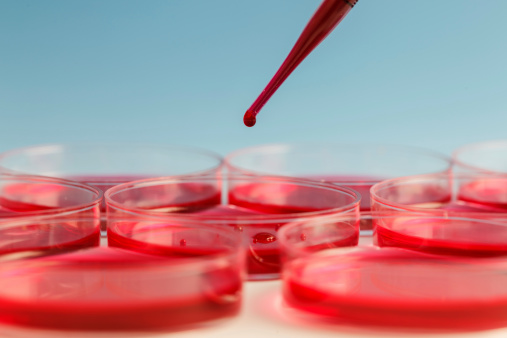Graduate school is, for many, the first big dose of “failure is the mother of success.”
After my first grant application came back with a substantially worse score on the revision submission than on the initial submission (how is that possible?), and the paper I was working on was rejected for the third time, my well-intentioned-but-innocent friends from undergrad made the mistake of introducing me one evening at a happy-hour event as “This is Ashley—she’s curing cancer!” Begin the awkward pity party.
Understanding Acute Myeloid Leukemia
My Ph.D. work as part of the M.D./Ph.D. program at Albert Einstein College of Medicine of Yeshiva University began when I joined an ongoing project in the laboratory of Ulrich Steidl, M.D., Ph.D., studying the development of leukemia. Leukemia is an aggressive blood cancer in which stem cells fail to develop properly into mature cell types and, instead, multiply uncontrollably at an immature stage of differentiation. Patients lack healthy mature blood cells, and their bone marrow, blood and other tissues become crowded with cancer cells, resulting in symptoms such as infections, fatigue and bleeding. The type of leukemia we study—acute myeloid leukemia (AML)—has a particularly poor clinical outcome, with less than one third of patients achieving lasting remission after treatment.

I was excited to work on this project because the approach was to collect data from the cancer cells of human patients and use this information to study the disease through experiments we can do in the laboratory. Studying data collected from 600 human patients with AML, we found that levels of a protein called HLX are elevated in the majority of patients, and that higher HLX expression correlates with worse overall patient outcome.
The Role of Stem Cells in AML
Research shows us that cancers such as AML develop over time. They are caused by the accumulation of mutations, which must take place in a certain order, in the blood stem cells in our bone marrow. If we could understand which changes occur first, we might design new therapies to target and eliminate malignant cells, and one day even be able to prevent leukemia development.
In our study, we found that levels of HLX increase in the stem cells early on in the process of leukemia development. We then showed that inhibiting HLX could slow the growth of leukemia cells, indicating that HLX, or its downstream molecular pathways, might one day be used for diagnosing and treating AML. Excited by our findings, we prepared our manuscript.
Patience and Persistence: The Rx for Publication
Unfortunately, as with many scientific articles submitted to journals, once our project met peer review at a journal (after that series of outright rejections), it seemed in some ways to move sideways for a while as we answered reviewers’ comments for over a year. Admittedly, however, many of the reviewers’ suggestions did lead to exciting new findings that we might not have pursued without their insight, and our paper was eventually published in 2012 in the journal Cancer Cell.
Planting the Seeds of Collaboration
Once it was published and our data were available to the research community, other research groups were able to read about our work. One of the most gratifying aspects of finally publishing that paper has been seeing other groups build on our results, and even approach us for collaborations. Some of the ideas raised by the initial paper have led to successful grants funding future research so that we can keep making progress in understanding leukemia and blood development.
Research in science often means weeks, months or even years of trying things and not getting the expected results. Fortunately, however, with persistence, a good team and a bit of a thick skin, research can be very rewarding.

